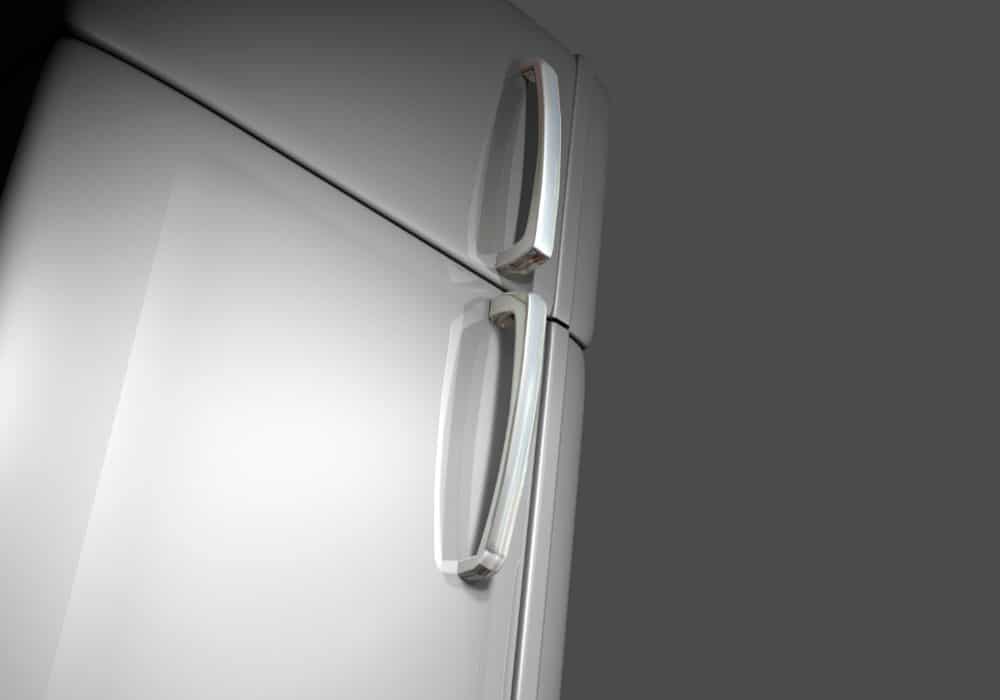Have you ever wondered about the weight of the refrigerator in your house? We all know that these appliances can be heavy, especially if we have had to move them from one position to another. However, how much does a refrigerator weigh?
You may need to check the weight of the cooling appliance in your house if you have to move it to another destination. That will mean placing it in an appliance dolly, which requires a lot of strength. Nevertheless, all refrigerators do not have the same size, so they are not all the same weight.
We discuss weight based on the type of fridge in this article. We also look at factors that add to the weight and why weighing the refrigerator is important.
Average Weight of a Refrigerator
The average weight of a refrigerator is 250 pounds. The weight can change based on the type and model, so some weigh less while others weigh more. A mini fridge may weigh only about 60 to 70 pounds, while a French-door refrigerator can weigh as much as 300 pounds.
The cubic-foot capacity of a refrigerator may indicate the overall weight of the appliance. Every refrigerator is measured based on the depth and volume of the space inside it, measured in cubic feet. A typical refrigerator weighs about 12 pounds for each cubic foot. With this number in mind, you can estimate the weight of a 20-cu. ft.refrigerator, which is around 240 pounds.
However, this is only an estimation to give you an idea of what to expect with each refrigerator. The brand, type, and accessories may also affect the weight. In other words, some brands may have heavier refrigerators than others.
Calculating the Weight of a Refrigerator Based on the Type

Correctly calculating how much your refrigerator weighs puts things in perspective. You can tell how much food and drinks it can hold and make purchases accordingly. It helps prevent food wastage and overstocking the appliance, which may affect its performance capacity.
We commonly use five refrigerator types in different households and other spaces. You will find a mini refrigerator, a two-door top-freezer refrigerator, a two-door bottom-freezer refrigerator, a side-by-side refrigerator, and a French-door refrigerator. A French-door refrigerator may be a 3-door, 4-door, or 5-door type.
Each brand may have other refrigerator types that are unique to its name, such as the flex door refrigerators you find with the LG, Hisense, and Samsung brands. But you can put this type under the French-door category, although its size and what it can carry may affect its overall weight.
1. Mini Refrigerators
As the name suggests, a mini refrigerator is the smallest type available. It typically has a fresh food section and a tiny freezer compartment. The fridge does not hold much, but it is the perfect size and capacity for small rooms such as dorm rooms.
Its size also means it is lightweight, so you may find an average mini refrigerator weighing between 30 and 50 pounds. It works best for easy movement or for conserving space. You may not need assistance moving or positioning, and a mini refrigerator is quite affordable.
2. Two-door Top Freezer Refrigerators
This type of refrigerator is compact and also an excellent option if you want to conserve space. But while it can be conservative when it comes to space, some top-mount refrigerators are quite bulky. In other words, you may find a few weighing higher than the average type.
A typical top-mount refrigerator can weigh between 160 and 260 pounds, depending on the brand and accessories. It is a common type that many homes use because of the combination of a freezer and refrigerator. It tends to have a sizable freezer, but nothing compared to larger models.
From its size, you can tell it is the next in weight to a mini fridge, but the capacity is worlds apart from the former. However, you can still use it to conserve space without compromising on your home’s refrigerating needs. It is also an affordable option if you cannot splurge on a bigger-sized refrigerator.
3. Two-door Bottom Freezer Refrigerators

This refrigerator type is not as common as the top-freezer type, so you may not easily find it. Some refrigerator manufacturers design their top-mount models to be convertible so that you can turn the top part into the refrigerating section and the bottom part into a freezer section.
However, a bottom-mount refrigerator may weigh slightly more than a top-mount model. You may find one that weighs as much as 250 pounds, probably because of the weight of the bottom freezer. Also, it costs slightly more than its sister refrigerator, so it may not be the best option for conserving space or saving money.
4. Side-by-Side Refrigerators
A side-by-side refrigerator is a heavy-duty model common with many large households. If you have the room and budget for a large refrigerator, this refrigerator type may be the best option. It has a lot of freezer and refrigerator space to hold food and drinks since it usually has a large capacity.
A side-by-side refrigerator averagely weighs between 240 and 350 pounds. The weight is different based on the brand and accessories, but this estimate cuts across all brands. You can also get the exact weight for your side-by-side by checking the cubic-foot capacity and multiplying it by 12.
Note that this refrigerator type tends to be more expensive than top-mount or bottom-mount models. Also, its accessories and design may affect the price. However, it is a worthy investment that will last a long time.
5. French-door Refrigerators
A French-door refrigerator weighs the most because of the multiple drawers and accessories. While it may be sleek and can change your kitchen’s look in a second, you must have enough space to accommodate it. Besides, it is usually the most expensive option on the list.
This refrigerator type has a minimum of three doors, meaning you can find one with five doors. This makes the average French-door refrigerator quite bulky, as it can weigh as much as 360 pounds. Of course, the weight depends on the cubic-foot capacity, but it provides plenty of storage space for your food and drinks.
Factors Affecting a Refrigerator’s Weight

Now that you know how much a typical refrigerator can weigh, you must also consider factors that can increase it. These factors should inform you whether or not a refrigerator choice is the best option.
1. Features and Accessories
A refrigerator without an ice maker or water dispenser, and ice dispenser will weigh less than one with these features. Other features and parts of the refrigerator can change the weight of a side-by-side model and make it heavier than a french-door model.
2. Age
Older refrigerator models weigh more than newer models. The older ones may have propulsion tanks and other components that brands have modernized or removed. As a result, they are less bulky. Some older top-mount refrigerators may weigh as much as 300 pounds.
So the year a refrigerator is manufactured is vital to its weight. The older the model is, the likelier it is to be heavy.
3. Model
The refrigerator type is also a key factor in how much it weighs. A French-door or flex-door refrigerator typically weighs more than other models. However, some side-by-side models weigh even more than others, but it depends on the brand and its features.
The Importance of a Refrigerator’s Weight
If you are wondering why weighing your refrigerator is important, consider the area weight, dead load, and floor support. While newer-model refrigerators are lighter, they can still carry some weight that can damage flooring or other supports.
1. Dead Load
If your floor has any covering, such as a carpet or tiles, it is a dead load that adds to the weight. The flooring material is also vital to the load calculation, so consider the area you want the refrigerator. If a lot of dead weight is added to the refrigerator weight, you may want to put it in another place.
2. Live Load
The live load of any floor depends on the flooring material. For example, the live load of a concrete floor is much higher than that of a wood floor. A live load is the weight of non-permanent fixtures around the house, such as people, furniture, and equipment.
Evenly distributing the weight around the house can make all the difference. However, selecting a refrigerator based on your home floor’s live load capacity and the refrigerator’s weight is crucial.
3. Floor Condition
Another important factor is the condition of the floor. If the floor is wood, consider the age and possible damage from moisture. If it is new flooring, it may comfortably carry the weight, both dead and live. But if it is an old floor, choosing a heavy refrigerator may cause extensive damage.
Bottom Line
Knowing how much a refrigerator weighs is crucial to selecting the right size refrigerator. An average refrigerator’s weight can be as little as 60 pounds or as much as 350 pounds. The model and type determine the weight. You must consider the layout, flooring, and age of the house.
Consider other appliances you already have and how much weight they put on the floor. Having the space to put a sleek French door or side-by-side refrigerator may be excellent, but keep these factors in mind when weighing your appliance.
